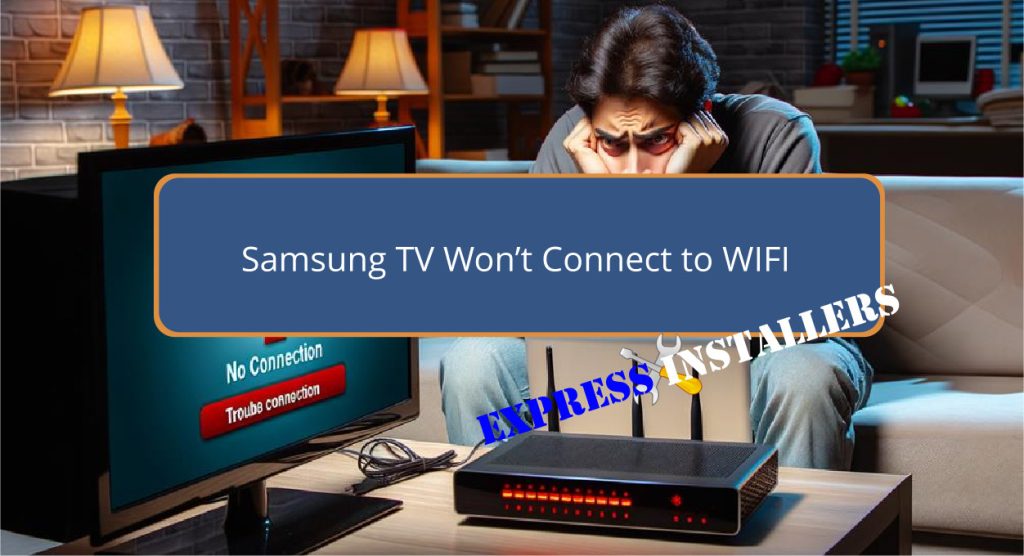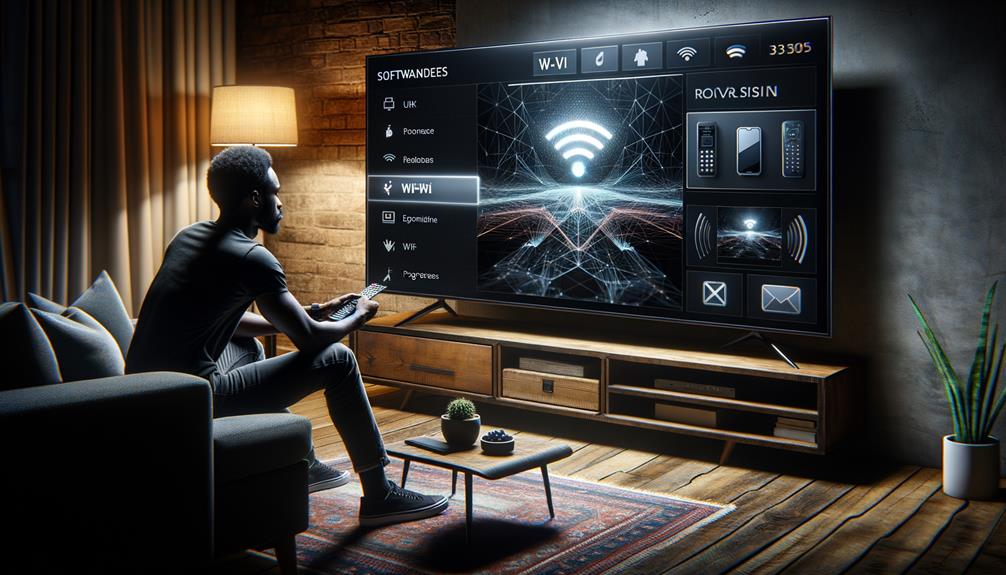
If your Samsung TV won’t connect to WiFi, start by checking the TV’s network settings and ensuring it is correctly configured to your router.
If the connection issue persists, manually set the IP configuration by entering specific network details such as IP address, subnet mask, gateway, and DNS directly in the TV’s network settings.
Additionally, consider updating the TV’s software to improve connectivity and overall performance.
This can typically be done through the TV’s menu using either a direct internet connection or a USB drive.
A final step, if required, might involve performing a factory reset to clear any lingering connectivity issues.
By exploring these solutions further, you can enhance the performance and connectivity of your Samsung TV.
Quick Summary
- Verify that your Samsung TV is connected to the correct Wi-Fi network in the network settings menu.
- Restart both your Samsung TV and the Wi-Fi router to resolve temporary connectivity issues.
- Update your Samsung TV software via the TV menu or a USB drive to fix bugs affecting Wi-Fi connectivity.
- Manually configure your TV’s IP settings to ensure a stable connection if automatic DHCP assignment fails.
- Perform a factory reset on your Samsung TV to clear any software glitches that may prevent Wi-Fi connections.
Identifying Connectivity Issues
To effectively identify connectivity issues with your Samsung TV, start by examining the link between your TV and the router to make sure there are no interruptions in the connection.
Implement troubleshooting steps by checking the network settings on your TV to confirm it is configured to connect to the correct Wi-Fi network.
Additionally, assess the router and internet box status to verify they are operational and broadcasting internet properly.
Connect another device to your Wi-Fi to rule out a network-wide issue. If other devices can connect successfully, the problem may be isolated to your Samsung TV.
If persistent issues occur, contacting your internet provider might be necessary to resolve deeper network-related problems.
Manual IP Configuration Steps
Manually configuring the IP settings on your Samsung TV often resolves persistent Wi-Fi connectivity issues effectively.
To begin this network troubleshooting technique, access the network settings menu on your TV.
Here, switch the IP settings from ‘DHCP‘ (automatic) to ‘Manual.’ Input the IP address, subnet mask, gateway, and DNS information exactly as provided by your Internet Service Provider.
Ensuring these values are accurately entered is vital, as any deviation can lead to further connectivity problems.
This manual assignment of IP details can stabilize the connection by circumventing issues related to automatic IP assignment failures.
These troubleshooting steps are essential for creating a dependable network environment for your Samsung TV, optimizing its connectivity performance.
Updating Samsung TV Software

Updating the software on your Samsung TV is vital for maintaining peak performance, enhancing security, and guaranteeing access to the latest features and app compatibility.
It resolves common issues and is an important troubleshooting step when facing connectivity problems.
You can update your TV’s software directly through its menu or by using a USB drive if the online update fails.
| Method | Description | Considerations |
|---|---|---|
| Online Update | Directly via TV menu | Requires stable internet connection |
| USB Update | Using a downloaded file from Samsung’s website | Useful if WiFi is problematic |
| Auto Update | Set TV to update automatically | Ensures always running latest version |
Regularly check for updates to minimize bugs and enhance user experience. This proactive approach helps in keeping your TV compatible with all new apps and services.
Resetting Your Samsung TV
After addressing software updates, another effective troubleshooting method for Wi-Fi connectivity issues is resetting your Samsung TV.
This process involves performing a factory reset, which clears temporary glitches and restores network settings to their original state, potentially resolving persistent Wi-Fi problems.
To execute this, navigate through the TV’s settings menu to find the reset option.
It’s important to note that this step will erase all customized settings, requiring you to re-enter Wi-Fi network information and other preferences once the reset is complete.
Following these troubleshooting steps, as outlined in our network troubleshooting guide, should allow your TV to reconnect to your Wi-Fi network, thereby restoring wireless connectivity.
Frequently Asked Questions
Why Is My Samsung TV Suddenly Not Connecting to Wi-Fi?
If your TV is suddenly unable to connect to Wi-Fi, consider verifying for software updates and evaluating potential signal interference. Confirm the device’s firmware is current and assess the environment for obstructions or electronic interference.
Why Is My TV Not Connecting to Wi-Fi but Everything Else Is?
If your TV fails to connect to Wi-Fi while other devices succeed, investigate potential router issues or interference sources. Assess the Wi-Fi signal strength and channel, ensuring they’re optimized for minimal disruption.
Why Is My Samsung Not Connecting to Wi-Fi?
To address your Samsung device’s Wi-Fi connectivity issues, verify router compatibility and check for any pending software updates that might improve network interaction. Restarting the device and router may also resolve connection problems.
How Do I Get My Samsung TV to Recognize My Wi-Fi?
To facilitate your Samsung TV to recognize your Wi-Fi, perform a network settings reset and verify router compatibility. Confirm the router’s frequency and settings align with your TV’s networking capabilities for the best connection.
Conclusion
In conclusion, resolving connectivity issues on Samsung TVs involves a systematic approach encompassing several strategies. Initially, identifying the root cause of the disruption is essential.
Subsequently, configuring the IP settings manually, updating the device’s software, and potentially performing a factory reset are effective steps.
Each method addresses different aspects of the problem, enhancing the likelihood of restoring stable Wi-Fi connections, thereby ensuring the television functions efficiently within a networked environment.
